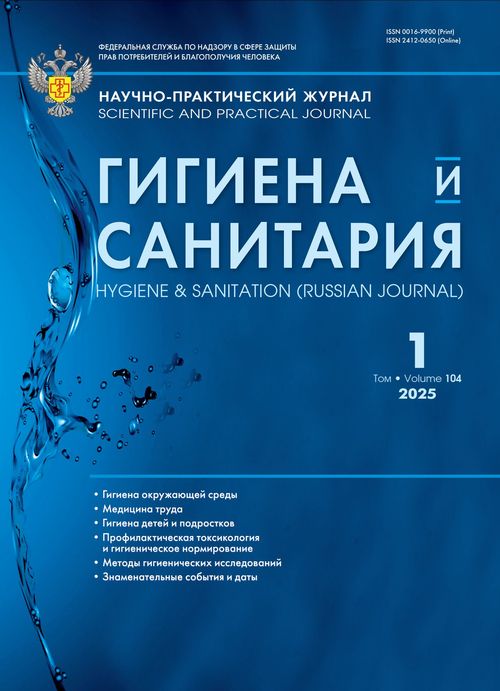Features of the work activity and health status in station and shunting dispatchers at the railway transport
- Authors: Ovechkina Z.V.1
-
Affiliations:
- All-Russian Scientific Research Institute of Transport Hygiene
- Issue: Vol 104, No 1 (2025)
- Pages: 71-75
- Section: OCCUPATIONAL HEALTH
- Published: 15.12.2025
- URL: https://edgccjournal.org/0016-9900/article/view/655516
- DOI: https://doi.org/10.47470/0016-9900-2025-104-1-71-75
- EDN: https://elibrary.ru/ocdduq
- ID: 655516
Cite item
Abstract
Introduction. One of the urgent problems of occupational hygiene is the optimization of working conditions and the protection of the health in workers at the railway transport. Technical progress at the railway transport, the introduction of modern automation tools, and the gain in the operational capacity of railways place special requirements for such occupations referred to the group of dispatching and operator occupations. One of the leading occupations among this category of workers is the profession of station and maneuver dispatchers. Chronic exposure to nervous and emotional stress in station and maneuver dispatchers can contribute to the development of pathological conditions in various organs and systems of the body and cause corresponding diseases. Therefore, an in-depth study of the working conditions of station and shunting dispatchers is relevant and timely.
The purpose of the study to investigate the working conditions in station and shunting dispatchers of the railway transport with the development of preventive measures.
Materials and methods. Time-lapse studies were carried out (photo of the working day). Measurements of harmful production factors in the workplace were carried out using the method of special assessment of working conditions. The structure of morbidity has been studied.
Results. According to the conducted research, it was found that the duration of concentrated attention for shunting dispatchers is 93.3%, for station dispatchers 87.7%. The average signal density per hour is 304 for the station dispatcher, and 311 for the maneuvering dispatcher. The load on the organs of hearing and vision was established. The hearing load for station dispatchers was 4–8 hours, for maneuver dispatchers – 5–7 hours, including talking on the “phone” and “selector”. During the work of the dispatcher, complex tasks are solved with a choice according to known algorithms (work according to a series of instructions), which takes 73.5–79.3% of the working time for station dispatchers, 70.8–96.3% for maneuvering dispatchers. Morbidity rates with temporary disability in the above-mentioned occupations are much higher than the industry average.
Limitations. Stations and branches were selected as the basic facilities for conducting hygienic research at the Moscow, Oktyabrskaya, and Sverdlovskaya railways.
Conclusion. The work activity in station and maneuver dispatchers is characterized by a significant
amount of work, including speech (semantic), signal (auditory), sign and visual information. This allows characterizing it as operator labour against the background of a high degree of stress factors. According to the indicators of the intensity of the labour process, the working conditions in station and maneuver dispatchers are classified as strenuous work of the 3rd grade of harmfulness, class 3.3. Employees of this occupation category have a high incidence of temporary loss of ability to work in terms of the number of cases of disability of 149.0 and the number of days of disability of 1,800, 8 per 100 employees. The average duration of the one case is 12.1 days. Based on the conducted research there were developed preventive recommendations, including rehabilitative psychohygienic means, and methods of improving the health in operator personnel and knowledge workers.
Compliance with ethical standards. The study does not require the submission of the conclusion of the Biomedical ethics committee or other documents.
Conflict of interest. The authors declare no conflict of interest.
Acknowledgement. The study had no sponsorship.
Received: December 4, 2024 / Revised: December 27, 2024 / Accepted: January 9, 2025 / Published: January 31, 2025
About the authors
Zhanna V. Ovechkina
All-Russian Scientific Research Institute of Transport Hygiene
Author for correspondence.
Email: ovechkina555@gmail.com
DSc (Medicine), Head of the Laboratory of Communal Hygiene and Epidemiology, All-Russian Scientific Research Institute of Transport Hygiene, Moscow, 125438, Russian Federation
e-mail: ovechkina555@gmail.com
References
- Kemaeva M.V. Research of personal characteristics of personnel in relation to the tasks of professional selection [Issledovanie lichnostnyh osobennostej personala primenitel'no k zadacham professional'nogo otbora]. Moscow; 2005. https://elibrary.ru/qxlxnx (in Russian)
- Alpaev D.V. Features of diurnal and seasonal rhythms of heart rate changes in shift workers. Meditsina truda i promyshlennaya ekologiya. 2017; 57(7): 136. https://elibrary.ru/zcpynp (in Russian)
- Bukhtiyarov I.V., Bobrov A.F., Denisov E.I., Eremin A.L., Kur'erov N.N., Losik T.K., et al. Occupational risk assessment methods and their information support. Gigiena i Sanitaria (Hygiene and Sanitation, Russian journal). 2019; 98(12): 132730. https://doi.org/10.18821/0016-9900-2019-98-12-1327-1330 https://elibrary.ru/khteai
- Gorblyanskii Yu.Yu., Sivochalova O.V., Kontorovich E.P., Kachan T.D., Piktushanskaya T.E., Khoruzhaya O.G., et al. Shift Work and the Risk of Health Problems [Smennaya rabota i risk narushenii zdorov'ya]. Rostov-na-Donu; 2016. https://elibrary.ru/xsdurn (in Russian)
- Matyukhin V.V., Yampolskaya E.G., Shardakova E.F., Elizarova V.V. Visual fatigue in video display terminal users in relation to the type of displayed information. Gigiena i Sanitaria (Hygiene and Sanitation, Russian journal). 2010; 89(2): 5760. https://elibrary.ru/mrmhal (in Russian)
- Bolshakova V.A. Assessment of the influence of working conditions on the functional state of the organ of vision of users of personal electronic computing machines: Diss. Moscow; 2005. https://elibrary.ru/nqmzrl (in Russian)
- Kudrin R.A., Kochegura T.N. Influence of cardiac rhythm and emotional intelligence parameters on efficiency of operators work. Vrach-aspirant. 2010; 42(5.1): 17282. https://elibrary.ru/muyerr (in Russian)
- Vlasova E.M., Alekseev V.B., Nosov A.E., Ivashova Yu.A. State of vegetative nervous system in workers engaged into multiple shifts work with night shifts. Meditsina truda i promyshlennaya ekologiya. 2016; 56(8): 2832. https://elibrary.ru/wjhxgh (in Russian)
- Ford E.S., Capewell S. Proportion of the decline in cardiovascular mortality disease due to prevention versus treatment: public health versus clinical care. Annu. Rev. Public Health. 2011; 32: 522. https://doi.org/10.1146/annurev-publhealth-031210-101211
- Kavada T. Long working hours and the risk of coronary heart disease. Am. J. Ind. Med. 2016; 59(4): 6337. https://doi.org/10.1002/ajim.22524
Supplementary files









